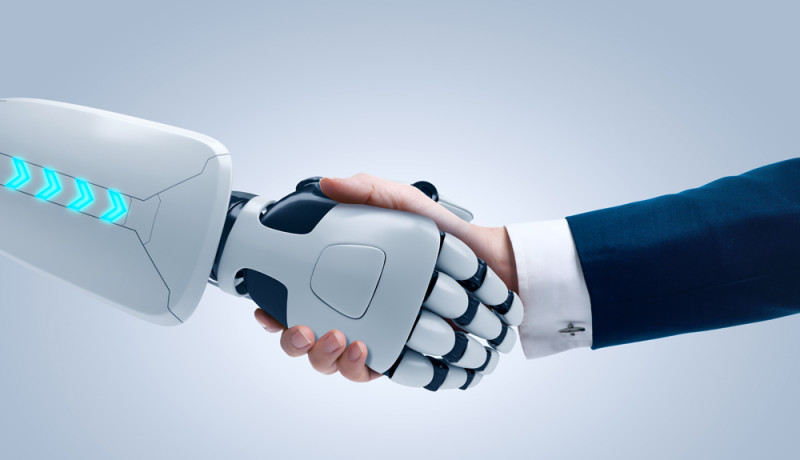Collaborative robots: a helping hand for industry
January 31, 2019
on
on

Robot is a noun first coined by Karel Čapek nearly 100 years ago in his sci-fi play R.U.R. (Rossum’s Universal Robots). His term was based on the Czech word for forced labour. Today the concept has evolved and softened considerably: many of the current generation of robots are collaborative robots, or cobots.
It’s long been feared that robots will be the harbingers of yet more negative disruption brought about by the application of technology – whether that’s in the industrial sector or even on the domestic front. Robots are frequently viewed as the agents of change that will see workers displaced from their roles or domestic help completely eclipsed. The advent and introduction of new technology is often accompanied by fear, based on a lack of knowledge about what the future will hold or how the technology will develop and fit alongside life in its current form. Fear of the unknown is a common – and fully understandable – human trait.
A more reasonable – and realistic – view of robots should be of them as assistants rather than direct replacements. While there are huge strides being made in the area of artificial intelligence, there’s a long way to go before robots are capable of being fully autonomous, of being able to think their way rationally through establishing or performing a task while at the same time being able to accommodate all the minute variations that can occur during the execution of that task. Some form of programming is always required; the robots are not capable of knowing what or how they are required to perform.
Robots were initially introduced to manufacturing environments to help speed up the process of automation and provide improvements in terms of operational efficiency. They were designed to take on boring, repetitive tasks, freeing humans up to perform jobs that would allow them to use their intuition and/or apply their intelligence. Robots could also perform heavy lifting activities that would otherwise test humans’ abilities and potentially cause physical damage or injury. One of the main disadvantages to replacing humans by robots is the loss of knowledge and skills acquired by those humans, possibly over the course of many years, that will result from the substitution.
These early robots were designed to perform separately from humans, in a space of their own. They were programmed to stop working immediately should their space be encroached upon, so as to avoid causing any harm to human workers. Physical barriers and locking systems were used to ensure that humans and robots remained in their separate spaces. If a human enters the robot’s workspace, the robot ceases work immediately – or at least slows to a fraction of its normal work speed to avoid causing harm to the human. These robots are generally static: a robotic arm is mounted on a stationary base.
It’s long been feared that robots will be the harbingers of yet more negative disruption brought about by the application of technology – whether that’s in the industrial sector or even on the domestic front. Robots are frequently viewed as the agents of change that will see workers displaced from their roles or domestic help completely eclipsed. The advent and introduction of new technology is often accompanied by fear, based on a lack of knowledge about what the future will hold or how the technology will develop and fit alongside life in its current form. Fear of the unknown is a common – and fully understandable – human trait.
A more reasonable – and realistic – view of robots should be of them as assistants rather than direct replacements. While there are huge strides being made in the area of artificial intelligence, there’s a long way to go before robots are capable of being fully autonomous, of being able to think their way rationally through establishing or performing a task while at the same time being able to accommodate all the minute variations that can occur during the execution of that task. Some form of programming is always required; the robots are not capable of knowing what or how they are required to perform.
Robots were initially introduced to manufacturing environments to help speed up the process of automation and provide improvements in terms of operational efficiency. They were designed to take on boring, repetitive tasks, freeing humans up to perform jobs that would allow them to use their intuition and/or apply their intelligence. Robots could also perform heavy lifting activities that would otherwise test humans’ abilities and potentially cause physical damage or injury. One of the main disadvantages to replacing humans by robots is the loss of knowledge and skills acquired by those humans, possibly over the course of many years, that will result from the substitution.
These early robots were designed to perform separately from humans, in a space of their own. They were programmed to stop working immediately should their space be encroached upon, so as to avoid causing any harm to human workers. Physical barriers and locking systems were used to ensure that humans and robots remained in their separate spaces. If a human enters the robot’s workspace, the robot ceases work immediately – or at least slows to a fraction of its normal work speed to avoid causing harm to the human. These robots are generally static: a robotic arm is mounted on a stationary base.
Read full article
Hide full article


Discussion (0 comments)